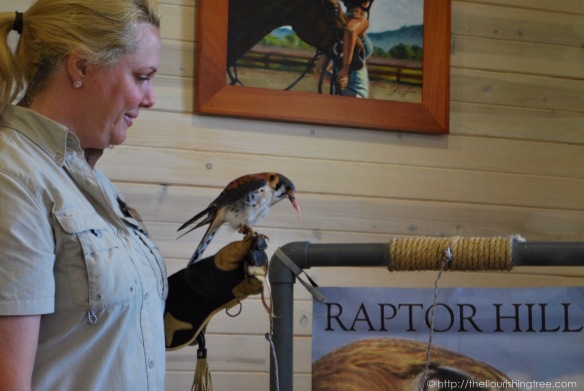I’ve always enjoyed watching birds in my backyard and the occasional hawk soaring along the highway, but the last few years have changed how I watch birds and brought a deeper appreciation for them.
You’ve been able to join me on this birding journey as I’ve chronicled a range of birds, from hummingbirds to vultures to ospreys to owls. I want to introduce you today to my new favorite. His name is Buddy, and he’s an American Kestrel.
My husband and I were on a trip with several of his co-workers and their spouses. We carved out time to mix in some fun between the work meetings and signed up for a falconry class. I was beyond excited about the class, even though none of us had any clue what to expect.
Jennifer Westhoff, owner of Raptor Hill and our instructor for the day, brought two of her birds for us to meet: Buddy and Gobi. She regaled us with a brief history of falconry and stories about her birds’ habits and training. Then came the part we were all waiting for. She let us put on gloves so Buddy could fly to us.
I was nervous but didn’t want to let any anxiety stop me from something I had been anticipating for months.
Meeting Buddy and learning of the these little hunters’ decline made me want to run right out and buy land with hay fields where I could put up Kestrel boxes. I’ll have to satisfy myself with the owl box for now. (If you have land with hay fields, would you please consider putting up kestrel boxes?)
Next we got to meet Gobi, Westhoff’s newest bird. He’s a Lanner Saker hybrid who emigrated from Canada. Due to (crazy-involved) wildlife export requirements, Gobi’s Canadian owner surrendered him, and Westhoff was able to take him in three weeks before we met him.
She suspected Gobi would be great with people, and because she wants him comfortable coming into her classrooms, we got to be guinea pigs for the day. He was wonderful, possibly in part because he watched Buddy fly back and forth to us, filling up on delicious treats (mice parts—yum, yum). Gobi was ready for his turn with the treats.
I don’t think any of us left the class disappointed. What an experience to interact with these exquisite birds.
Do you have a favorite bird (a species or an individual)?
By the way, Westhoff told us there are only three types of birds not legally protected in the US. Want to guess what they are? (No fair using Google.)






Since at least one of you is getting restless for the answers, here they are: feral pigeons, English sparrow, European starling. Congrats to each of you for guessing at least one correct one! 🙂
Thank you!! = )
Crows, blue jays and pigeons??
Thanks for guessing! I’ll reveal the answers in the next few days. 🙂
Oooh! Good Answer – I didn’t even think about Crows! = )
What an awesome idea and a fun adventure! That little Buddy sure is cute. = ) The coloring is remarkable.
I’m wondering if the city pigeon ( not sure of the technical name) is one of the non-protected birds? They are always in abundance and leave their “calling cards” all over the place.= (
My favorite birds are “sand peeps” as I like to call them – or the technical term is Sanderling (Sandpipers). They are absolutely adorable running all over the beach puffed up on their tiny black legs! = )
Sandpipers are fun to watch, especially as they dodge the surf. Thanks for taking a guess. I’ll give others a little longer to guess before revealing the three answers. I know what you mean about pigeons’ unwelcome calling cards. I think of the pigeons around North Carolina’s state capitol grounds — the poor statues there!
I feel an undeniable urge to google the answer…im SO curious! Besides, a little bird told me to do it. hahahaha
Can I tell you how insanely jealous I am? I want to do a falconry class!
And (without google), I’ll take a stab at your question. I think that the species that are not protected are the invasive ones–European starlings, house sparrows aren’t protected here (or at least their nests aren’t).
I hope you get to take one some day. It was awesome! I’ll give a little more time for others to guess before giving the answers. Thanks for playing! 😉